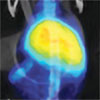| Mar 30, 2022 |
|
(Nanowerk News) The CIC biomaGUNE Molecular and Functional Biomarkers group has developed a rapid, cost-effective, synthetic, microwave method for producing ultra-small manganese ferrite nanoparticles that act as advanced, multimodal contrast agents in magnetic resonance imaging (MRI) and positron emission tomography (PET); they also have intracellular catalytic activity as a result of which an unprecedented reduction in tumor growth can be induced, for materials of this type, in a preclinical model of breast cancer.
|
|
The results of this research, published by the journal Small (“Ultrasmall Manganese Ferrites for In Vivo Catalase Mimicking Activity and Multimodal Bioimaging”), demonstrate that these nanoparticles have robust characteristics for nanobiotechnological applications.
|
|
Ultrasmall manganese ferrite nanoparticles are made up of iron, manganese and oxygen; they are iron oxide particles measuring about 4 nanometers and have manganese integrated inside their crystal structure.
|
|
Traditionally, these types of particles are produced by means of time-consuming organic processes that require tedious purification phases. In these cases, their organic coating was making it impossible for them to be used in aqueous or biological environments.
|
|
However, by using a rapid, microwave-assisted method in this work, “we were able to demonstrate that it is possible to produce these water-soluble nanoparticles that are ready for use in cells as well as in preclinical studies, and which are simultaneously very efficient as contrast agents for MRI and as catalase-mimicking nanozymes.
|
|
In addition, this synthesis allows radioisotope labelling for PET imaging contrast purposes, which broadens its application in bioimaging”, said Susana Carregal, associate researcher at CIC biomaGUNE and CIBERES.
|
|
In this study, the research group to which Carregal belongs has proven “both in vitro and in preclinical studies of breast cancer that these nanoparticles reduce the hydrogen peroxide and increase the level of oxygen inside the tumor cells. These two small molecules control important cellular functions with direct implications for the onset of diseases such as pulmonary fibrosis or cancer, so these nanozymes could be used in treatments in which the regulation of these metabolites is crucial,” explained Carregal.
|
A library of nanoparticles with various magnetic and catalytic properties
By means of small changes, this research group has produced a library of 14 particles with various magnetic and catalytic properties: “We can control the amount of manganese we insert into the particles without altering properties such as charge or size, which are important with respect to their biosafety and biodistribution within the body. By adjusting the amount of manganese, we can get the nanozymes to adopt various imaging and catalytic properties,” said Dr Carregal. That way, the most appropriate nanozyme could be selected depending on the chosen application.
|
|
“The fact that PET can be carried out simultaneously alongside MRI and the fact that the particles themselves demonstrate attenuation of tumor growth is a remarkable advance. This had not been seen before. The particles did not normally exert an impact on tumor growth on their own,” as Carregal pointed out.
|
|
These promising applications are opening up new avenues for the development of more efficient theranostic agents (agents that perform both therapeutic and diagnostic functions). “In principle, this is a study at a preliminary stage, it demonstrates the potential of these materials,” she added.
|
|
The researcher insisted that “there is still a long way to go. Although we have come up with a more efficient and less costly synthetic process, and we have demonstrated its impact on cell biology, the study of the adjustment mechanisms of the metabolites and long-term biosafety would need to be developed further.
|
|
The research group has provided a valuable tool in the field of nanozymes “thanks not only to their catalytic efficiency, but also to their combined use as a multimodal contrast agent. However, there is still a lot of research work to be done until their potential scope is proven in applications that can have an impact on society,” concluded Carregal.
|

